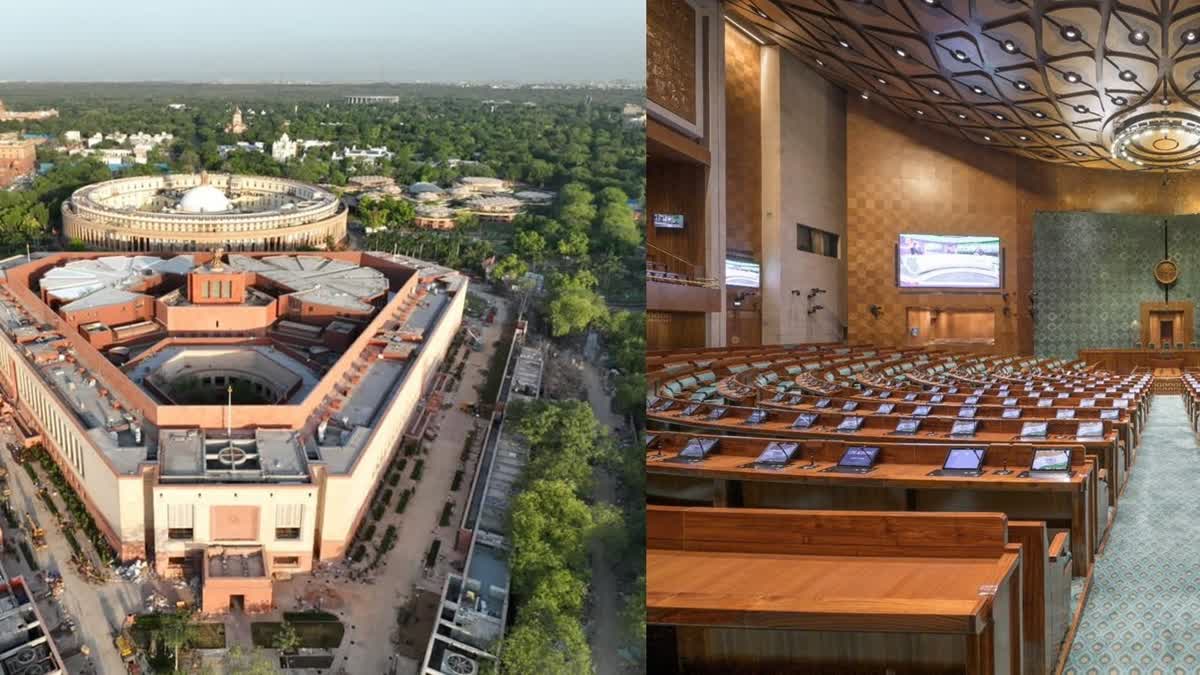Hyderabad: Amid the opposition boycott of its inauguration, the new Parliament building is being hailed for representing India's rich diversity with key construction material sourced from different states and union territories. The new parliament building which is part of the Central Vista Project is scheduled to be inaugurated by Prime Minister Narendra Modi along with Lok Sabha Speaker Om Birla on Sunday, May 28.
With carpets from Mirzapur in Uttar Pradesh, bamboo flooring from Tripura and stone carvings from Rajasthan, the new Parliament building reflects India's diverse culture. Similarly, the teakwood used in the building was sourced from Nagpur in Maharashtra, while the red and white sandstone was procured from Sarmathura in Rajasthan. The sandstone for the Red Fort and Humayun's Tomb in the national capital was also known to have sourced from Sarmathura.
The Kesharia green stone has been procured from Udaipur, the red granite from Lakha near Ajmer and the white marble has been sourced from Ambaji in Rajasthan. "In a way, the entire country came together to construct the temple of democracy, thus reflecting the true spirit of Ek Bharat Shreshtha Bharat," an official said.
The steel structure for the false ceilings in the Lok Sabha and the Rajya Sabha chambers have been sourced from the union territory of Daman and Diu, while the furniture in the new building was crafted in Mumbai. The stone 'jaali' (lattice) works dotting the building were sourced from Rajnagar in Rajasthan and Noida in Uttar Pradesh.
The materials for the Ashoka Emblem were sourced from Aurangabad in Maharashtra and Jaipur in Rajasthan, while the Ashok Chakra donning the massive walls of the Lok Sabha and the Rajya Sabha chambers and the exteriors of the parliament building were procured from Indore in Madhya Pradesh. The new parliament building used manufactured sand or M-sand from Charkhi Dadri in Haryana for creating concrete mix for the construction activities.
M-Sand is considered environment-friendly as it is manufactured by crushing large hard stones or granite and not by dredging of river beds. The fly ash bricks used in the construction were sourced from Haryana and Uttar Pradesh, while brass works and pre-cast trenches were from Ahmedabad in Gujarat.
The new Parliament building, constructed by Tata Projects Ltd, will have a grand constitution hall to showcase India's democratic heritage, a lounge for MPs, a library, multiple committee rooms, dining areas and ample parking space. The triangular-shaped four-storey building has a built-up area of 64,500 square metres. The building has three main gates -- Gyan Dwar, Shakti Dwar, and Karma Dwar. It will have separate entrances for VIPs, MPs, and visitors.
The new Parliament building can comfortably seat 888 members in the Lok Sabha chamber and 300 in the Rajya Sabha chamber. In the case of a joint sitting of both Houses, a total of 1,280 members can be accommodated in the Lok Sabha chamber.
Significantly, the number of Lok Sabha seats has remained unaltered at 545 based on the delimitation carried out on the basis of 1971 Census and is likely to increase substantially after 2026 as the freeze on total number of seats is only till 2026 thereby necessitating the need for a vast parliament building. The seating arrangements in the present parliament are cramped and cumbersome, with no desks beyond the second row.
Also read: This is how the new Parliament building will look like



